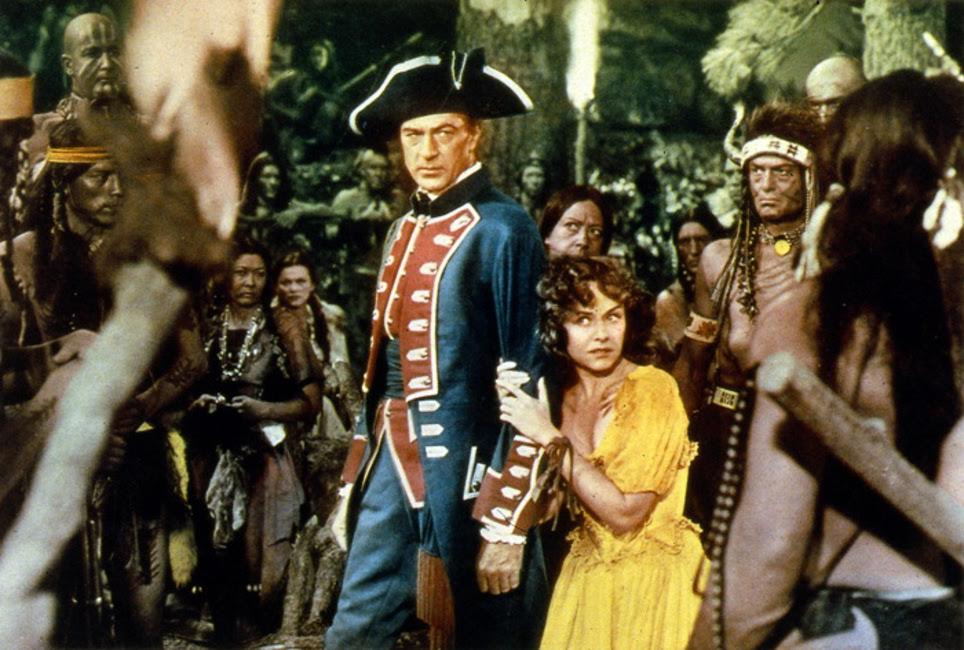
Unconquered is the best movie you’ve never heard of. Made alongside other MGM epics like Ben-Hur and The Ten Commandments, and boasting an all-star cast, its production value is high, but its ultimate strength is in the power of its narrative: it breaks all the PC taboos. On the strength of its traditional colonial narrative, it is one of the best in cinematic history.
Based on true events, this adaptation from Neil Swanson’s novel by the same title, Unconquered centers around the life of Abby (Paulette Goddard), an English peasant girl who by order of a London court is sold into slavery in the New World circa 1760. So the film opens on the subject of White slavery in early America, depicting mass import of English, Irish, and Scottish slaves.
This is the substance of Michael Hoffman’s groundbreaking work, They Were White and They Were Slaves, which proves that upward of 3/4 of Whites in colonial America arrived under some circumstance of bonditure. Which in turn means that slavery in America was predominantly a trade in White flesh rather than Black. Most slaves brought to these shores were sons and daughters of the British isles. Though not taboo at the time of the film’s release, that point alone precludes this film from mainstream acceptance today.
But it only gets better as Abby is bought by the benevolent slaveholder and hero of the film, Capt. Christopher Holden (played by Gary Cooper). I know. A slavemaster as hero? Imagine.
And get this — she was actually happy to be purchased by Holden, and hoped he had marriage in mind! Today a segment like this would provoke marches on DC, pink-knit genital hats and all.
Turns out though, Holden only purchased the girl to keep her from the clutches of his co-bidder, Martin Garth (Howard Da Silva), the central villain of the story. But just as Holden doesn’t fit the PC template of hero, neither does Garth, by modern lenses, fit the mold of villain: miscegenating with the Indians and arming them against the settlers in prelude to Pontiac’s Rebellion, an open campaign of racial genocide against Whites, he is the “antiracist” in the story.
There is also a subplot having to do with Garth’s Indian wife and her jealousy over Garth’s desire for Miss Abby. In spite of his status as a race-traitor, it becomes evident that his sullen squaw is no helpmeet to a White man, so he designs to leave his Red woman for White – a circumstance that provokes the Indian woman to vengeance against all parties.
Neither does the film pull punches on the subject of Indian savagery in general: many foreboding references are made to “what Indians do to White women.” The Indians massacre Whites, homestead by homestead, men, women, and children; and when Abby falls into their hands, they set out to torture her to death with glowing firebrands and torches.
But in a show of daring and superior intellect on Holden’s part, he uses the Indians’ superstition against them to affect Abby’s rescue. Which concludes with one of the epic battles of both American and cinematic history, as the confederation of Indian tribes crashes like a tidal wave on the timberwalls of Fort Pitt. All ambiguity is dispelled: White Christians must fight for the lives of their own against the relentless Indian savagery.
This is a vindication of the true dynamics of race in colonial days as told in the old history books. And by virtue of conformity with the journaled testimonies of those who lived through those times, it is the Christian interpretation, too: sentiments just as in Ben-Hur, to which MGM was compelled for the sake of a national audience who were still majority Christian.
At its heart is the pedagogical contrast between the persons of Holden and Garth: one, a White man faithful to his people, the other a race-traitor whose compromised union inclines him to wage war on his own; thus proving Matthew Henry’s conclusion concerning the Israelites who had mingled with the races of the land in the books of Ezra and Nehemiah: “A sinful love leads to a sinful league.” By the confusion of miscegenation men are that much more confused. It exacerbates all biases against truth and right. This was the wisdom ever handed down by our Christian sires on the subject, which they learned from the twin witnesses of experience and Scripture.
But in an age overrun with the likes of Garth and his savages, the remaining Holdens are cast as the villains. And that isn’t just speculation on my part. We see just this in the recent period piece, The Revenant (2015), the true story of Hugh Glass (played by Leo DiCaprio). In the real story, Glass was a trapper and Indian fighter, but in the film adaptation he was ward to a half-breed Indian son, and his quest for vengeance against his would-be killers is turned into a social justice crusade against the “racist” White men who killed his little Injun. They transformed a great true story into transparent anti-White propaganda. Heck, by the time it got around to the grizzly attack scene, I was rooting for the bear.
In any case, Unconquered is the real deal, a rare gem of a film for family night.
| Tweet |
|
|
|




